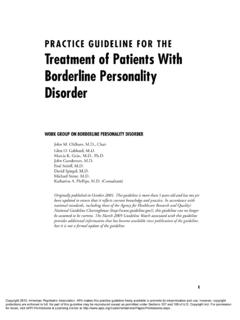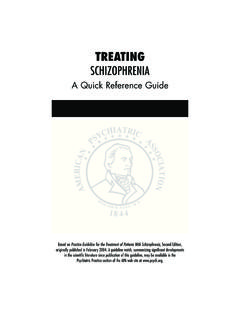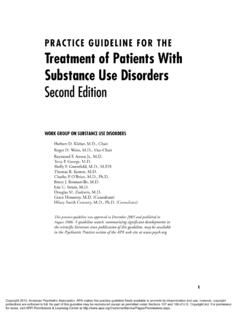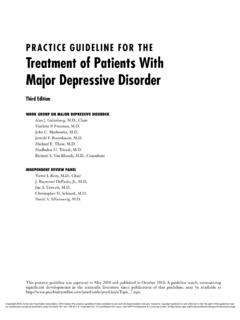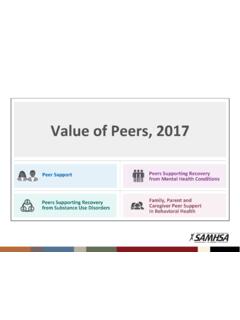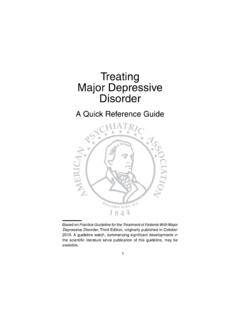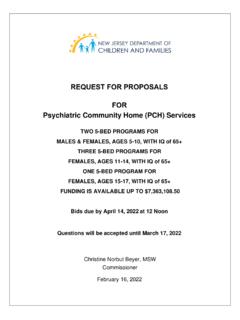Transcription of A Quick Reference Guide - Psychiatry
1 Based on Practice Guideline for the Treatment of Patients With Schizophrenia,Second Edition,originally published in February 2004. A guideline watch, summarizing significant developments in the scientific literature since publication of this guideline, may be available in the psychiatric Practice section of the APA web site at Quick Reference GuideAmerican psychiatric Association Steering Committee on Practice GuidelinesJohn S. McIntyre, , ChairSara C. Charles, , Vice-ChairDaniel J. Anzia, A. Cook, T. Finnerty, R. Johnson, E. Nininger, Summergrad, M.
2 Woods, , Yager, and Component LiaisonsRobert Pyles, (Area I)C. Deborah Cross, (Area II)Roger Peele, (Area III)Daniel J. Anzia, (Area IV)John P. D. Shemo, (Area V)Lawrence Lurie, (Area VI)R. Dale Walker, (Area VII)Mary Ann Barnovitz, Hafter Gray, Saxena, Tonnu, Editors, Quick Reference GuidesMichael B. First, J. Fochtmann, Kunkle, , Senior Program ManagerAmy B. Albert, , Assistant Project ManagerClaudia Hart, Director, Department of Quality Improvement and psychiatric ServicesDarrel A. Regier, , , Director, Division of ResearchStatement of IntentThe Practice Guidelines and the Quick Reference Guides are not intended to beconstrued or to serve as a standard of medical care.
3 Standards of medical care aredetermined on the basis of all clinical data available for an individual patient andare subject to change as scientific knowledge and technology advance and practicepatterns evolve. These parameters of practice should be considered guidelines to them will not ensure a successful outcome for every individual, norshould they be interpreted as including all proper methods of care or excludingother acceptable methods of care aimed at the same results. The ultimate judg-ment regarding a particular clinical procedure or treatment plan must be made bythe psychiatrist in light of the clinical data presented by the patient and the diag-nostic and treatment options development of the APA Practice Guidelines and Quick Reference Guideshas not been financially supported by any commercial organization.
4 For moredetail, see APA s Practice Guideline Development Process, available as an appen-dix to the compendium of APA practice guidelines, published by APPI, and onlineat TREATINGSCHIZOPHRENIA122A. psychiatric Management1. Assess symptoms and establish a Formulate and implement a treatment plan ..1233. Develop a therapeutic alliance and promote treatment adherence ..1244. Provide patient and family education and therapies ..1245. Treat comorbid conditions ..1256. Attend to the patient s social circumstances and functioning.
5 1257. Integrate treatments from multiple clinicians ..1258. Carefully document the treatment ..125 OUTLINEB. Acute Phase1. Assessment ..1262. psychiatric Management ..1273. Use of Antipsychotic Medications ..1284. Use of Adjunctive Medications ..1355. Use of ECT and Other Somatic Therapies ..1366. Special Issues in Treatment of First-Episode Stabilization Stable Phase1. Psychosocial Use of Antipsychotic Medications ..1414. Use of Adjunctive Medications ..1425. Use of Encourage Patient and Family to Use Self-Help Treatment Organizations.
6 142E. Special Issues in Caring for Patients WithTreatment-Resistant Illness ..142F. Treatment of Deficit Symptoms ..143G. Choice of Treatment Setting or Housing ..144 TREATINGSCHIZOPHRENIA 123A. psychiatric ManagementReevaluate the patient s diagnosis and update the treatment plan asnew information about the patient and his or her symptoms Assess symptoms and establish a an accurate diagnosis, considering other psychoticdisorders in the differential diagnosis because of the major implica-tions for short- and long-term treatment planning.
7 If a definitivediagnosis cannot be made but the patient appears prodromallysymptomatic and at risk for psychosis, reevaluate the the targets of each treatment, use outcome measures thatgauge the effect of treatment, and have realistic expectations aboutthe degrees of improvement that constitute successful the use of objective, quantitative rating scales to monitorclinical status ( , Abnormal Involuntary Movement Scale [AIMS],Structured Clinical Interview for DSM-IV Axis I Disorders [SCID], BriefPsychiatric Rating Scale [BPRS], Positive and Negative SyndromeScale [PANSS]).
8 2. Formulate and implement a treatment specific type(s) of treatment and the treatment setting. (Thisprocess is iterative and should evolve over the course of the patient sassociation with the clinician.) TREATINGSCHIZOPHRENIA124 Assess factors contributing to incomplete treatment adherence andimplement clinical interventions ( , motivational interviewing) toaddress them. Factors contributing to incomplete treatment adherenceinclude patient s lack of insight about presence of illness or need to takemedication, patient s perceptions about lack of treatment benefits ( ,inadequate symptom relief) and risks ( , unpleasant side effects,discrimination associated with being in treatment)
9 , cognitive impairment, breakdown of the therapeutic alliance, practical barriers such as financial concerns or lack oftransportation, cultural beliefs, and lack of family or other social Develop a therapeutic alliance and promote treatment adherence. Identify the patient s goals and aspirations and relate these totreatment outcomes to increase treatment assertive outreach (including telephone calls and homevisits) for patients who consistently do not appear for appointments orare nonadherent in other Provide patient and family education and therapies.
10 Work with patients to recognize early symptoms of relapse in orderto prevent full-blown illness the family about the nature of the illness and copingstrategies to diminish relapses and improve quality of life for 125 Work with team members, the patient, and the family to ensure thatservices are coordinated and that referrals for additional services aremade when Attend to the patient s social circumstances and Treat comorbid conditions, especially major depression, substance use disorders, and posttraumatic stress Integrate treatments from multiple Carefully document the treatment, since patients may have different practitioners over their course of Acute PhaseGoals of treatment Prevent harm.



